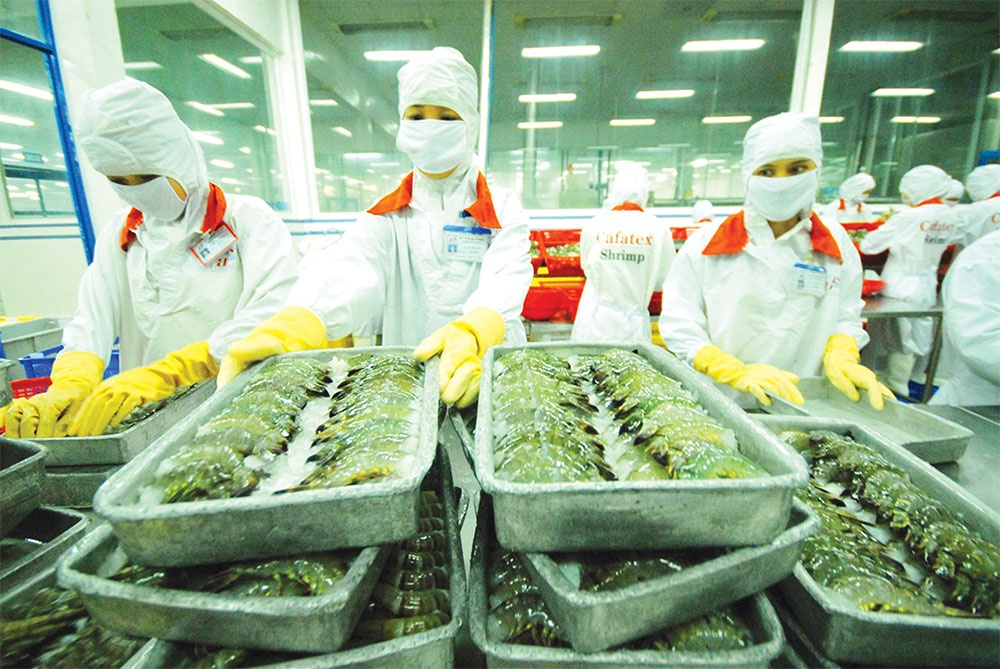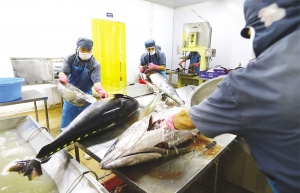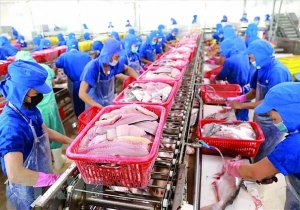Seafood exporters tasked with improving their game
At Thai Minh Long Seafood Co., Ltd. in the Mekong Delta province of Bac Lieu, the best shrimp shipments are being prepared for export to the European market, which is the basis for this business to achieve its growth target of 150 per cent in 2022. Thai Minh Long has signed more than 80 per cent of contracts in 2022 and is “continuing to restructure the processing line to better meet the EU’s requirements on the rule of origin,” said Tran Van Dieu, chairman of Thai Minh Long.
 |
| Seafood groups have to pass a strict set of standards to be allowed to deal with EU member nations. Photo: Le Toan |
Vietnam’s seafood exports in 2022 could reach $10 billion with the contribution of signed trade deals. The zero-tariff advantage from Vietnam’s agreement with the EU (EVFTA) is rendering Vietnam’s seafood prices more competitive in the bloc, but it entails the challenge of implementing regulations on the origin of seafood input materials.
Tran Van Lap, chairman of Loc Kim Chi Seafood JSC in the Mekong Delta province of Vinh Long, admitted, “Domestic raw materials and production capacity cannot fully meet the criteria on the EVFTA’s rule of origin in the short term. Raw materials for seafood processing in Vietnam still depend on imports, especially shrimp.” He said that the lack of synchronous infrastructure and high production costs and prices are “reducing competitiveness” compared to shrimp materials of other countries.
Europe is paying more attention to food safety, especially after the pandemic. Claus Nodrup, sales manager of the Frozen Seafood Department at I. Schroeder KG from Hamburg at a webinar in April this year, said, “The demand and selling price of seafood originating from Vietnam is increasing.” He noted, however, that businesses in the EU require imported products with transparent, honest, and accurate certifications.
Over time, the EU has gradually tightened the rules on socially and environmentally-responsible production practices for imported seafood. For instance, the most important part of the new EU organic farming regulation is that producers from developing countries must comply with the same set of rules as European ones. The EU wants to ensure that all organic products sold in its territory are of the same standard.
The European Commission (EC) in March further presented an action plan for the development of organic production with the aim to promote the production and consumption of organic products, including organic aquaculture. The action plan is also designed to drive demand, maintain consumer confidence, and bring organic food closer to the nearly 600 million people in the market.
However, meeting the rules of origin will be more difficult. The EC started applying a new maximum mercury residue threshold on May 3, stipulating that mercury residues in seafood can range from 0.3-1 microgramme per kg, depending on the product type. Products already on the market will be consumed until their respective expiry date.
Truong Dinh Hoe, general secretary of the Vietnam Association of Seafood Exporters and Producers (VASEP), said, “Implementing the rules of origin of goods has many problems. Similar to most rules of origin in other trade deals, the EVFTA requires that seafood materials used for semi-processed or processed seafood must be raised, harvested, or caught in Vietnam, or alternatively originate from the EU. For example, for caught seafood, especially tuna, more than four-fifths of raw materials must be imported from countries and territories that do not have FTAs with Vietnam.
“Seafood and tuna exporters have not taken full advantage of the FTA with the EU,” commented Hoe. “Additionally, the HS code conversion criteria have not been expanded, making it impossible for enterprises to use materials imported from countries outside the bloc for production and export to the FTA’s member countries.
According to the VASEP, the EU is a large market with many market segments and products. Over the past 10 years, Vietnam’s seafood production has increased steadily from 4.9 million tonnes in 2009 to 8.7 million tonnes in 2021. Vasep believes that Europeans are increasingly preferring products with white fish because of health factors, while the awareness of environmental protection and seafood resources also raises, offering opportunities for farmed fish for export.
 | Vietnam’s seafood exporters suffering with euro fluctuation Following exchange fluctuations, Vietnamese seafood exporters are now faced with catastrophic changes in their orders, forcing them to lower export prices or find other solutions to stay competitive in the long run. |
 | Strong rebound in seafood exports to Russia Once falling to a standstill due to the impacts of the Russia-Ukraine conflict, Vietnam’s seafood exports to Russia are now showing inspiring results after the last few months. |
 | Bright prospects for agri-seafood exports at year-end Surging consumption in US and EU markets by the year-end and China’s loosened policy on importing commodities are expected to underpin Vietnam’s export acceleration in the forthcoming months. |
What the stars mean:
★ Poor ★ ★ Promising ★★★ Good ★★★★ Very good ★★★★★ Exceptional
Related Contents
Latest News
More News
- Human-centred governance seen as key to AI development (December 19, 2025 | 18:19)
- Top 10 notable events of Vietnam’s industry and trade sector in 2025 (December 19, 2025 | 14:00)
- Tungsten surges to 12-year high as world enters a new 'black gold' race (December 18, 2025 | 17:27)
- Vietnam’s coffee exports set new record despite price pressures (December 18, 2025 | 17:13)
- Garment and textile sector seeks new growth after volatile year (December 18, 2025 | 17:01)
- VinSpeed and Siemens strengthen cooperation for high-speed rail development (December 18, 2025 | 16:53)
- High-tech adoption for TH true MILK (December 18, 2025 | 13:39)
- Takeda supports health resilience amid climate change challenges (December 18, 2025 | 12:39)
- Mondelez Kinh Do - a chapter of purpose-led leadership in Vietnam (December 18, 2025 | 09:44)
- VNPAY services receive the highest-level PCI DSS international security certificates for six consecutive years (December 17, 2025 | 23:47)

 Tag:
Tag:






















 Mobile Version
Mobile Version